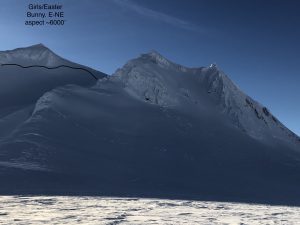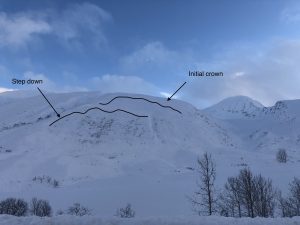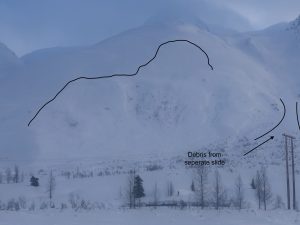Valdez
Above 3,000ftModerate
1,500 to 3,000ftLow
Below 1,500ftLow
Degrees of Avalanche Danger
Avalanche Problems
Problem 1
The 1/14 buried surface hoar layer that was the weak layer responsible for the most recent natural avalanche cycle has been found on all aspects above 2500′ in the intermountain and continental zone, but not the maritime zone. This layer is buried 1.5-3 feet in depth and has produced propagation in stability tests as recently as 1/28, although results have been mixed. Identifying the 1/14 BSH is becoming increasingly difficult as it is now laid flat, is rounding and the weight of the slab above has been mixing it with the snow beneath. The likelihood of triggering an avalanche at this layer is decreasing as temperatures have been mild, and we haven’t received any major loading by precipitation or wind in the last 6 day. If you were to trigger an avalanche at this layer, wide propagation would be expected as the overlying slab has settled and become dense (4 finger-1 finger).
Signs of instability may not exist even when dangerous conditions are present. Digging snowpits is the most effective way to identify where this layer is present and its sensitivity. Although, this can be a difficult assessment tool due to spatial variability (conditions that vary from place to place) and results that may be confusing or misleading. This layer is becoming more subtle and could easily be missed.
Likelihood:
- Almost Certain
- Very Likely
- Likely
- Possible
- Unlikely
Size:
- Historic
- Very Large
- Large
- Small
Trend
- Increasing
- Steady
- Decreasing
Problem 2
Weak snow exists near the base of our snowpack in all three climate zones. A step down avalanche occurred during the 1/23-25 storm on Nicks Buttress (see avalanche activity section). The was the first activity at this layer since 1/6, but does show that weak snow near the base of the snowpack can still produce avalanches.
Faceted snow near the ground has been found to vary from place to place. In most locations this snow has been found to be rounding (gaining strength) and unreactive in stability tests. In thin areas of the snowpack these facets are significantly more developed. On 1/31 a very thin snowpack was found (28-36 inches) ~4000′ on Nicks buttress/North aspect. Stability tests produced propagation near the ground failing on 6mm depth hoar. The most likely places to affect weak snow near the ground will be in areas where the snowpack is thin.
Tracks on a slope are not a sign of stability with this problem.

Depth hoar from Nicks Buttress ~4000′ North aspect 1/31.
Likelihood:
- Almost Certain
- Very Likely
- Likely
- Possible
- Unlikely
Size:
- Historic
- Very Large
- Large
- Small
Trend
- Increasing
- Steady
- Decreasing
Avalanche Activity
Below is a summary of observed Avalanche activity from the last 7 days. Avalanches that were noted earlier in the season can be viewed by clicking the link below.
If you trigger or observe a natural avalanche consider leaving a public observation.
1/26- A significant amount of avalanche activity occurred during the 1/23-25 storm. Avalanches were concentrated in the Intermountain and Continental zone and occurred on all aspects above 2000′. Most of the activity appears to have failed mid storm at the 1/14 buried surface hoar layer (see problem 1) with crowns filled back in. Notable avalanches occurred on: Crudbusters, Iguana Backs, Nicks Buttress, Gully 2 buttress, Little Girls, Easter Bunny, Averys, RFS.




Crudbusters north aspect ~4500′ SS-N-R2-D2.5

Hippie Ridge south aspect ~4000′ -SS-Ny-R1-D2

Giovanni (Buttress east of Nicks Happy Valley)north aspect ~3600′ SS-N-R3-D3. Stepped down to facets near the ground at ~3100′. This was the only avalanche reported or observed with a step down to deeper weak layers.

Buttress between Nick and Gully 2. north-northwest aspect ~3500′ SS-N-R4-D2.5

Weather
Check out our updated weather tab! A collection of local weather stations are available for viewing with graphs and tabular data included.
NWS Watches and warnings
NONE NWS Point forecast for Thompson Pass
Date Wednesday 02/01/23 Thursday 02/02/23 Time (LT) 06 12 18 00 06 12 18 00 06 Cloud Cover OV OV OV OV OV OV OV OV OV Cloud Cover (%) 85 90 95 95 90 85 80 85 85 Temperature 16 20 23 21 21 23 21 16 16 Max/Min Temp 25 20 24 16 Wind Dir NE E SE SE SE SE SE E NE Wind (mph) 8 4 3 3 3 3 3 3 3 Wind Gust (mph) 16 Precip Prob (%) 5 40 60 60 60 30 20 30 20 Precip Type S S S S S S S S 12 Hour QPF 0.04 0.09 0.06 0.04 12 Hour Snow 0.1 1.2 0.2 0.0 Snow Level (kft) 0.1 0.2 0.2 0.2 0.3 0.1 0.1 0.1 0.1
Click on link below for Thompson Pass weather history graph:

| Date:
02/02 |
24 hr snow | HN24W* | High temp | Low temp | 72 hour SWE* | February snowfall | Seasonal snowfall | Snowpack Depth |
| Valdez | 0 | 0 | 33 | 21 | .19 | 0 | 145 | 41 |
| Thompson pass | 0 | 0 | 24 | 17 | N/O | 0 | 286 | 48 |
| 46 mile | 0 | 0 | 30 | 16 | 0 | 0 | ~66** | 38 |
*HN24W- 24 hour Snow water equivalent in inches
*SWE– Snow water equivalent
**46 mile seasonal snowfall total begins December 1st.
Additional Information
Click on the link below for a running summary of the seasons weather history.
Announcements
The avalanche hazard is moderate above 3000 feet for the Maritime climate zone and low below. Triggering an avalanche is possible up to one foot in depth. The snowpack near the coast is gaining strength with recent mild temps, little to no precipitation in 6 days and calm winds. Instabilities may still exist in steep terrain.
Posted by Gareth Brown 02/01 8:30 am.
For a description of current avalanche problems, weather information, season history and more click the (+ full forecast) button. Avalanche forecasts will be issued Wednesday-Sunday.
If you have pictures of recent natural or human triggered avalanches or notice signs of instability such as shooting cracks or collapsing, leave an observation to help improve forecast accuracy.

